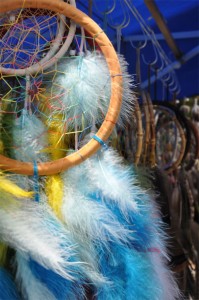
The Indigenous Women’s Alliance (IWA) and the Ethnic Studies Department put on a successful Mills College Pow Wow, an event celebrating Native American culture, on Saturday, April 16, despite cuts in funding.
The Provost’s Office reduced Pow Wow funding from an intended $5,000 to $2,500 this year given “dire economic circumstances,” according to email from Ethnic Studies Professor and IWA advisor Melinda Micco.
Shunkila Black Calf, an IWA leader, expressed her dismay at the decreased financial support.
“We really had the rug pulled out from under us with the financial situation,” Black Calf said. “In hard economic times, it’s always the marginalized people who pay first. They pay more dearly than everybody else. I see that playing out all over again on the Mills College campus where the priorities are for the Provost’s Office. We’re definitely not a priority on their list.”
Provost Sandra Greer writes in an email that her office did not intend to send that kind of message.
“There has been no deliberate reduction in support for the Pow Wow. Our office is happy to help and we do help,” Dr. Greer writes.
Dr. Micco said that Dr. Greer and the Provost’s Office are supportive of Native events.
Mills College Pow Wow expenses are paid each year through a collection of gifts plus money from the Provost’s Office, according to Dr. Greer.
Black Calf said that the Pow Wow budget has taken a nosedive over the years.
About 2-3 years ago, the Provost’s Office dedicated $8,000 per year to the Pow Wow. Over time, the annual $8,000 allocation got cut down to $5,000 before finally settling at this year’s $2,500, according to Black Calf.
Black Calf said she’s not sure who in the Provost’s Office makes these funding decisions.
“There hasn’t been a lot of communication directly between IWA and the Provost,” Black Calf said.
According to a representative of the Provost’s Office, IWA is one of the few student organizations that receives special funding from the Provost and the reduction in funding was necessary because of budget cuts within the administration.
A little less than three weeks before the Pow Wow, Black Calf and fellow IWA leader Ciera Cummings asked the Associated Students of Mills College (ASMC) for about $2,500 to cover the event’s remaining costs, which they received.
IWA’s pride and joy
Cummings said that consistent, reliable funding is key to having the Pow Wow every year, and is key to supporting the Native community on campus and in the Bay Area.

“By Mills having a Pow Wow,” Cummings said, “that’s a really broad statement not only to its own students but to the Oakland community that it supports the Native community, it supports Native students and this is a place that’s welcoming to Native students. So things like our funding getting cut is a large-scale message to us that we’re not a priority.”
Black Calf sees the Pow Wow event as an opportunity to reach out to the larger Native American community in Oakland.
“Mills has struggled a lot with the campus access issues,” Black Calf said. “I really want Mills to be able to reach out to the community and have a relationship with them.”
Many colleges, such as Stanford University and California State University, Long Beach, host a Pow Wow if there’s a Native American student group on campus.
“That’s kind of your capstone moment during the year,” Cummings said. “All your Native students work towards that throughout the school year. That’s our pride and joy. That’s a time for our outside Native community to come into the campus and for us to all celebrate together.”
At the Pow Wow, Native artists and cultural practitioners showcased their traditional crafts, dances and songs. The Pow Wow coordinators offered participants honorariums and prize money.
Black Calf said it feels good to help the Native community carry on its traditions.
“In financially hard times, people can tend to neglect hobbies and the art that they do and other extra curricular activities they participate in when they don’t have that financial stuff weighing on them,” Black Calf said.
The Pow Wow is also important when it comes to recruiting and retaining Native students, Dr. Micco said.
Cummings, referring to her first Mills College Pow Wow, said, “That’s when I really felt like I was a part of this community. I really felt like I belonged here.”
Underrepresentation
Black Calf said she would like Mills to recruit more Native students so they can have a stronger community.
“It’s really lonely sometimes being (one of) the only Native student(s) on campus,” she said.
One percent of Mills undergraduates have identified as Native American from 2006-2010, according to the Mills College Facts and Trends 2010 report from the Office of Institutional Research and Planning.
The Office of Undergraduate Admission recruits all students of color, according to an email Media Relations Manager Pam Scholtz sent on behalf of Dean of Undergraduate Admission Giulietta Aquino.
Several Bay Area high schools have been identified as schools which have significant numbers of Native American students, and admission counselors regularly visit and attend college fairs at some of these high schools throughout the recruitment season, Scholtz said.
Black Calf said she knows there are lots of talented Native students who’d like to come to Mills, but they need to have scholarships to make it easier for them to choose this college.
IWA is a really small group, Cummings said. She and Black Calf are the two students who organized the event, and four other IWA members help when they can.
Black Calf said that if this small group can pull off a Pow Wow for two consecutive years, even greater things could happen if Mills had more Native students.
Related article: Mills Native students respond to racist CSULB article
